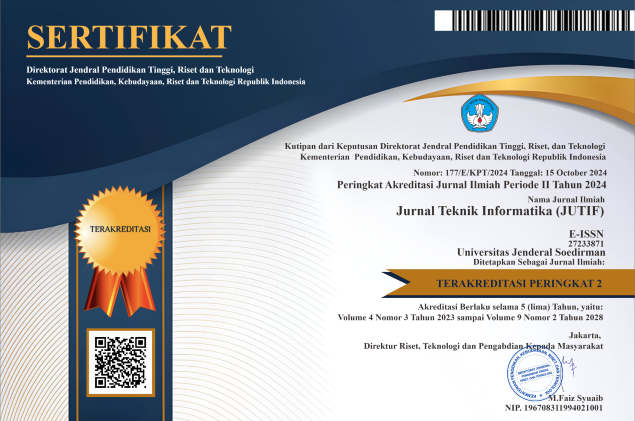Improving Direct Image Regression for Blood Cell Enumeration with a Fine-Tuned Backbone
DOI:
https://doi.org/10.52436/1.jutif.2025.6.4.5004Keywords:
Blood Cells Components, Complete Blood Count, Deep Neural RegressorAbstract
Complete blood count (CBC) examination provides an important insight for diagnosis or disease treatment. Currently, CBC examination requires complex and expensive devices that limit their deployment in remote area. The development of computer vision based method offers simplification to the process. However, its implementation is limited to the availability of large size labelled dataset. This research aims to develop a direct image regressor that is able to regress directly from image. There are two stages in estimation process. First, the backbone is trained using large dataset available for blood cell classification problem. Then the trained backbone is plugged into the final model by adding a fully connected neural network that acts as regressor. The whole model is then trained using limited whole blood cell count dataset. The evaluation process shows that training the backbone using large size related dataset improve the performance by 50%. This study can be used to create a low-cost blood component evaluation tool, particularly in rural areas where access to advanced laboratory equipment is limited.
Downloads
References
L. Agnello et al., “The Value of a Complete Blood Count (CBC) for Sepsis Diagnosis and Prognosis,” Diagnostics, vol. 11, no. 10, p. 1881, Oct. 2021, doi: 10.3390/diagnostics11101881.
E. O, “Interpretation of Full Blood Count Parameters in Health and Disease,” Haematol. Int. J., vol. 5, no. 1, pp. 1–25, 2021, doi: 10.23880/hij-16000180.
I.-H. Seo and Y.-J. Lee, “Usefulness of Complete Blood Count (CBC) to Assess Cardiovascular and Metabolic Diseases in Clinical Settings: A Comprehensive Literature Review,” Biomedicines, vol. 10, no. 11, p. 2697, Oct. 2022, doi: 10.3390/biomedicines10112697.
S. R. Comar, M. Malvezzi, and R. Pasquini, “Evaluation of criteria of manual blood smear review following automated complete blood counts in a large university hospital,” Rev. Bras. Hematol. E Hemoter., vol. 39, no. 4, pp. 306–317, Oct. 2017, doi: 10.1016/j.bjhh.2017.06.007.
R. Nithya and K. Nirmala, “Detection of Anaemia using Image Processing Techniques from microscopy blood smear images,” J. Phys. Conf. Ser., vol. 2318, no. 1, p. 012043, Aug. 2022, doi: 10.1088/1742-6596/2318/1/012043.
A. T. Gasparin et al., “Hilab system, a new point-of-care hematology analyzer supported by the Internet of Things and Artificial Intelligence,” Sci. Rep., vol. 12, no. 1, p. 10409, Jun. 2022, doi: 10.1038/s41598-022-13913-8.
S. Y. Kim and H. K. Kim, “Obtaining Reliable CBC Results in Clinical Laboratories,” Ann. Lab. Med., vol. 42, no. 5, pp. 505–506, Sep. 2022, doi: 10.3343/alm.2022.42.5.505.
A. Cordova-Gomez, A. P. Wong, L. B. Sims, G. F. Doncel, and L. J. Dorflinger, “Potential biomarkers to predict return to fertility after discontinuation of female contraceptives—looking to the future,” Front. Reprod. Health, vol. 5, Aug. 2023, doi: 10.3389/frph.2023.1210083.
N. Grimon, T. Ceccomarini, A. Maurel-Ribes, J.-B. Rieu, V. Mémier, and F. Dubois-Galopin, “Digital morphology analyzers in hematology: a French survey,” Ann. Biol. Clin. (Paris), vol. 78, no. 5, pp. 519–526, Oct. 2020, doi: 10.1684/abc.2020.1587.
E. V. Malasaga et al., “Complete Blood Count (CBC) Analysis Mobile Application,” in 2021 IEEE 13th International Conference on Humanoid, Nanotechnology, Information Technology, Communication and Control, Environment, and Management (HNICEM), Nov. 2021, pp. 1–6. doi: 10.1109/HNICEM54116.2021.9731857.
Á. Narrillos-Moraza et al., “Mobile Apps for Hematological Conditions: Review and Content Analysis Using the Mobile App Rating Scale,” JMIR MHealth UHealth, vol. 10, no. 2, p. e32826, Feb. 2022, doi: 10.2196/32826.
E. Frantz, H. Li, and A. J. Steckl, “Quantitative hematocrit measurement of whole blood in a point-of-care lateral flow device using a smartphone flow tracking app,” Biosens. Bioelectron., vol. 163, p. 112300, Sep. 2020, doi: 10.1016/j.bios.2020.112300.
S.-J. Lee, P.-Y. Chen, and J.-W. Lin, “Complete Blood Cell Detection and Counting Based on Deep Neural Networks,” Appl. Sci., vol. 12, no. 16, p. 8140, Aug. 2022, doi: 10.3390/app12168140.
B. Hemalatha, B. Karthik, C. V. Krishna Reddy, and A. Latha, “Deep learning approach for segmentation and classification of blood cells using enhanced CNN,” Meas. Sens., vol. 24, p. 100582, Dec. 2022, doi: 10.1016/j.measen.2022.100582.
L. Kamal and R. J. R. Raj, “Harnessing deep learning for blood quality assurance through complete blood cell count detection,” E-Prime - Adv. Electr. Eng. Electron. Energy, vol. 7, p. 100450, Mar. 2024, doi: 10.1016/j.prime.2024.100450.
A. HemaSri, M. D. Sreenidhi, V. V. K. Chaitanya, G. Vasanth, V. M. Mohan, and T. Satish, “Detection of RBCs, WBCs, Platelets Count in Blood Sample by using Deep Learning,” in 2023 International Conference on Sustainable Computing and Data Communication Systems (ICSCDS), Erode, India: IEEE, Mar. 2023, pp. 47–51. doi: 10.1109/ICSCDS56580.2023.10105115.
T. Xia, Y. Q. Fu, N. Jin, P. Chazot, P. Angelov, and R. Jiang, “AI-enabled Microscopic Blood Analysis for Microfluidic COVID-19 Hematology,” in 2020 5th International Conference on Computational Intelligence and Applications (ICCIA), Beijing, China: IEEE, Jun. 2020, pp. 98–102. doi: 10.1109/ICCIA49625.2020.00026.
S.-J. Lee, P.-Y. Chen, and J.-W. Lin, “Complete Blood Cell Detection and Counting Based on Deep Neural Networks,” Appl. Sci., vol. 12, no. 16, Art. no. 16, Jan. 2022, doi: 10.3390/app12168140.
M. M. Alam and M. T. Islam, “Machine learning approach of automatic identification and counting of blood cells,” Healthc. Technol. Lett., vol. 6, no. 4, pp. 103–108, 2019, doi: 10.1049/htl.2018.5098.
S. Thapa and D. L. Stachura, “Deep Learning Approach for Quantification of Fluorescently Labeled Blood Cells in Danio rerio (Zebrafish),” Bioinforma. Biol. Insights, vol. 15, p. 11779322211037770, Jan. 2021, doi: 10.1177/11779322211037770.
T. Xia, Y. Q. Fu, N. Jin, P. Chazot, P. Angelov, and R. Jiang, “AI-enabled Microscopic Blood Analysis for Microfluidic COVID-19 Hematology,” in 2020 5th International Conference on Computational Intelligence and Applications (ICCIA), Jun. 2020, pp. 98–102. doi: 10.1109/ICCIA49625.2020.00026.
Y.-M. Chen, J.-T. Tsai, and W.-H. Ho, “Automatic identifying and counting blood cells in smear images by using single shot detector and Taguchi method,” BMC Bioinformatics, vol. 22, no. 5, p. 635, Dec. 2022, doi: 10.1186/s12859-022-05074-2.
G. Drałus, D. Mazur, and A. Czmil, “Automatic Detection and Counting of Blood Cells in Smear Images Using RetinaNet,” Entropy, vol. 23, no. 11, p. 1522, Nov. 2021, doi: 10.3390/e23111522.
A. Sadafi, M. Bordukova, A. Makhro, N. Navab, A. Bogdanova, and C. Marr, “RedTell: an AI tool for interpretable analysis of red blood cell morphology,” Front. Physiol., vol. 14, May 2023, doi: 10.3389/fphys.2023.1058720.
T. Fang, X. Huang, X. Chen, D. Chen, J. Wang, and J. Chen, “Segmentation, feature extraction and classification of leukocytes leveraging neural networks, a comparative study,” Cytometry A, vol. 105, no. 7, pp. 536–546, 2024, doi: 10.1002/cyto.a.24832.
A. Kumar et al., “U-Net as a deep learning-based method for platelets segmentation in microscopic images,” Aug. 23, 2024, medRxiv. doi: 10.1101/2024.08.23.24312502.
A. Acevedo, S. Alférez, A. Merino, L. Puigví, and J. Rodellar, “Recognition of peripheral blood cell images using convolutional neural networks,” Comput. Methods Programs Biomed., vol. 180, p. 105020, Oct. 2019, doi: 10.1016/j.cmpb.2019.105020.
A. Bodzas, P. Kodytek, and J. Zidek, “A high-resolution large-scale dataset of pathological and normal white blood cells,” Sci. Data, vol. 10, no. 1, p. 466, Jul. 2023, doi: 10.1038/s41597-023-02378-7.
E. D. Cubuk, B. Zoph, D. Mané, V. Vasudevan, and Q. V. Le, “AutoAugment: Learning Augmentation Strategies From Data,” in 2019 IEEE/CVF Conference on Computer Vision and Pattern Recognition (CVPR), Jun. 2019, pp. 113–123. doi: 10.1109/CVPR.2019.00020.
K. He, X. Zhang, S. Ren, and J. Sun, “Deep Residual Learning for Image Recognition,” in 2016 IEEE Conference on Computer Vision and Pattern Recognition (CVPR), Jun. 2016, pp. 770–778. doi: 10.1109/CVPR.2016.90.
X. Feng, Y. Jiang, X. Yang, M. Du, and X. Li, “Computer vision algorithms and hardware implementations: A survey,” Integration, vol. 69, pp. 309–320, Nov. 2019, doi: 10.1016/j.vlsi.2019.07.005.
V. Plevris, G. Solorzano, N. Bakas, and M. Ben Seghier, “Investigation of performance metrics in regression analysis and machine learning-based prediction models,” in 8th European Congress on Computational Methods in Applied Sciences and Engineering, CIMNE, 2022. doi: 10.23967/eccomas.2022.155.
Additional Files
Published
How to Cite
Issue
Section
License
Copyright (c) 2025 Sigit Adinugroho, Yuita Arum Sari, Fitri Utaminingrum

This work is licensed under a Creative Commons Attribution 4.0 International License.



























